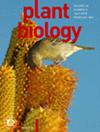光强和缺硫通过水通道蛋白调控花椰菜的生长和水分动态。
IF 3.6
3区 生物学
Q1 PLANT SCIENCES
引用次数: 0
摘要
硫在植物次生代谢中起着至关重要的作用,特别是在硫代葡萄糖苷的生物合成中,硫作为核心结构元件参与分子调控机制。此外,硫代谢与氮同化错综复杂,突出其在植物生理过程中的多面作用。光,另一个关键的非生物决定因素,直接调节作物生产力,光强度控制基本过程,如生长动力学和光合效率。本研究旨在阐明光胁迫和硫缺乏对受控环境条件下西兰花(Brassica oleracea var. italica)生长和水分动力学的影响,探讨光胁迫和硫缺乏单独和联合胁迫下的生理和分子机制。结果表明,缺硫对植物水分关系的影响强于光胁迫,而光胁迫主要影响光合活性和生物量积累。复合应激导致更明显的生理反应,包括不同于单一应激处理的不同的水通道蛋白调节模式。这些发现提示了一种有助于维持水分平衡的补偿机制,强调了硫有效性、光强和植物适应策略之间复杂的相互作用。本文章由计算机程序翻译,如有差异,请以英文原文为准。

Light intensity and sulfur deficiency modulate growth and water dynamics in broccoli plants via aquaporin regulation
求助全文
通过发布文献求助,成功后即可免费获取论文全文。
去求助
来源期刊

Plant Biology
生物-植物科学
CiteScore
8.20
自引率
2.60%
发文量
109
审稿时长
3 months
期刊介绍:
Plant Biology is an international journal of broad scope bringing together the different subdisciplines, such as physiology, molecular biology, cell biology, development, genetics, systematics, ecology, evolution, ecophysiology, plant-microbe interactions, and mycology.
Plant Biology publishes original problem-oriented full-length research papers, short research papers, and review articles. Discussion of hot topics and provocative opinion articles are published under the heading Acute Views. From a multidisciplinary perspective, Plant Biology will provide a platform for publication, information and debate, encompassing all areas which fall within the scope of plant science.
 求助内容:
求助内容: 应助结果提醒方式:
应助结果提醒方式:


